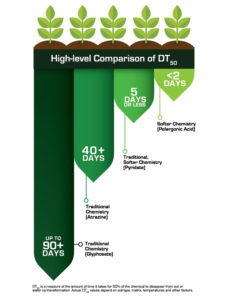How ‘Softer Chemistry’ in Crop Protection Addresses Increased Emphasis on Safety
With the recent implementation of the Food Safety Modernization Act, a spotlight is now being shone on the need for better safety procedures for commercial farming. That’s true not only for the handling of grown food, but also the type of water quality, soil amendments, and other applications being administered during produce cultivation.
It’s important to note that this regulation does not directly address chemicals used during farming. Nonetheless, the scrutiny being applied to how fruit and vegetable crops are grown and stored safely suggests that agribusiness professionals should take a closer look at alternatives to traditional products for crop protection and pest mitigation. (That’s not to say that traditional chemicals are unsafe, only that alternatives exist that might be useful in combination with these chemicals, or in place of them, depending on farmers’ needs.)
Across the industry, these alternatives are becoming known as “soft chemistry.”
Soft Chemistry and Biopreferred Applications
The soft chemistry movement is seeing some validation in the government, as the USDA is certifying some of these additives as “biopreferred.” Farmers can work to produce more safely grown fruits and vegetables by introducing more such products into their strategy for crop protection and pest control.
For the uninitiated, the USDA’s “BioPreferred Program,” created by the 2002 Farm Bill and expanded with additional legislation in 2014, looks at ways to increase the use of bio-based renewable materials derived from plants and other renewable agricultural, marine, and forestry materials.
Crop management solutions that are deemed “biopreferred” by the USDA offer a more natural (although not necessarily “organic”) alternative to suppress pests and improve crop yield. These substances provide safer and more sustainable alternatives to other pest control substances.
For example, USDA biopreferred crop protection and pest mitigation products may use pelargonic acid as their active ingredient. Pelargonic acid is a naturally-occurring substance that degrades into water and CO2. It’s safe for livestock and humans and can be synthesized from chemicals or made from plants or animal fat.
By increasing their focus on soft chemistry, farmers will begin to see less harmful effects to the environment and living creatures, improved crop yields – and possibly even greater effectiveness of other applications they already use in their crop protection strategy.
Lower-Impact Conventional Chemistry
Even in more conventional chemistry, there is an industry push to find ways to lower the chemical footprint for crop protection products. Industry experts are continually looking for chemicals with fewer residues, or ones that can be used in tank mixing, to reduce the concentration of chemicals that in the past would have found their way into soil.
That pursuit of lower-impact chemistry extends to chemicals such as dinoterfuran, which, while being a neonicotinoid, has fewer residuals and therefore a comparatively lower chemical footprint, or the post-emergence herbicide pyridate, which in certain applications leaves no residues. And the rest of the industry, in turn, is recognizing the efforts of manufacturers who pursue this approach to lower-impact chemistry. The Organic Materials Review Institute (OMRI) puts its OMRI Listed® Seal on pest control products, which assures the suitability of the listed products for certified organic production, handling, and processing. To be compliant with this listing for certified organic farmers, these products must be included in the operator’s approved organic farm plan, and must follow any restrictions described in the OMRI Products List© under the product’s category.
Nature and Sustainability
It’s no secret that success in farming, both as a business and in crop production, boils down to improving yield. If you can improve yield and mitigate pests while ensuring safer conditions for workers, livestock, and beneficial insects, you create a sustainable plan for successful farming, today and tomorrow.
Nature often gets in the way of farmers’ success, however. Across the country, farmers’ environmental and climate-related challenges make application of softer chemistry solutions an important way to continue to grow as a business.
Depending on where in the U.S. you live, you know about the particular obstacles Mother Nature can throw in your path. In the Pacific Northwest, for example, apple and cherry crops in particular have to be protected from damage such as sunburn.
Seasonal changes can also wreak havoc on pulse crops – chickpeas, lentils, dry peas, dry beans, and more – which account for 2.5 million acres of farmland in predominantly dry areas such as the Great Plains and western U.S. The 20 million acres of corn grown domestically are also susceptible to both climate and pest problems, which can dramatically affect the price paid by the American consumer and in foreign export channels.
On the other side of the spectrum from sun damage is freezing weather. According to a recent report by the University of Georgia College of Agricultural and Environmental Sciences, blueberry crops in the state were significant damaged by the winter freezes. That damage threatens to create fungal pathogens that can affect fruit production and yield in the state. (Similar problems are occurring elsewhere on the East Coast, including North Carolina and Michigan, as well as in Midwest states such as Michigan.)
Softer chemistry and biopreferred alternatives to traditional applications may not be the silver bullet that commercial farmers need to address the threats posed by annual changes in climate. But they are clearly where regulators are beginning to focus their attention, and even conventional chemical crop protection products are being developed with an eye toward limiting their environmental impact.
Compliance with new and existing regulations for better safety in food growth and handling demands that farmers develop creative, innovative and sustainable strategies for crop protection and pest control. Such strategies, adopting softer chemistry or biopreferred substances, can improve yield and reduce the chemical footprint in commercial farming, while still curbing the environmental threats to harvests every year.
Alan Haack, Ph.D. is the Technical Service Manager – West for Belchim Crop Protection USA, LLC. He can be reached at [email protected] or by phone at +1 916 755 1145.






